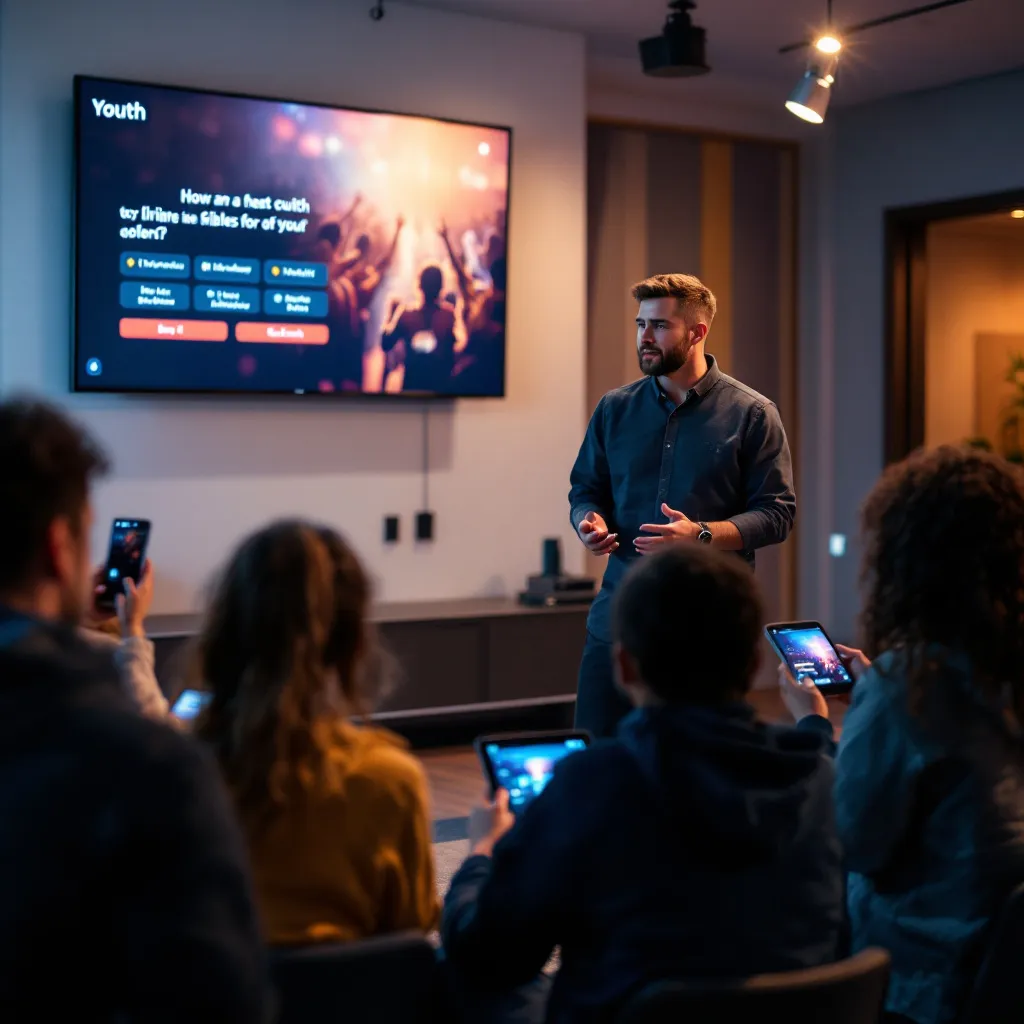Essential Digital Tools for Youth Pastors: How to Engage Gen Z in the Digital Age
Key Takeaways
- Gen Z youth prefer interactive, visual content on platforms like TikTok, Instagram, and YouTube for spiritual exploration
- A balanced approach combining digital tools with face-to-face interactions creates the most effective youth ministry
- Empowering youth to create their own faith-based content builds ownership and deeper connections
- Measuring engagement through both digital metrics and real-world participation helps track ministry impact
- Budget-friendly tools like YouVersion, Google Drive, and free social media platforms can transform youth ministry without breaking the bank
Youth ministry has undergone a dramatic transformation in recent years. The teenagers filling church youth rooms today have never known a world without smartphones, social media, and instant digital connection. This reality presents both challenges and opportunities for youth pastors seeking to make faith relevant and engaging.
Understanding Gen Z's Digital Habits and Preferences
Gen Z, born between 1997 and 2012, represents the first truly digital native generation. Their online habits differ significantly from previous generations, shaping how they experience everything—including faith. Understanding these unique characteristics is crucial for effective ministry:
- Visual Communication: Gen Z processes information primarily through images, videos, and graphics rather than text alone
- Authenticity: They value genuine, unfiltered content over polished perfection
- Short-Form Content: Their attention spans respond best to brief, engaging content that delivers value quickly
- Multi-Platform Presence: They seamlessly move between TikTok, Instagram, YouTube, and emerging platforms
Bridging the Gap Between Spiritual Growth and Digital Platforms
The digital landscape offers unique opportunities to connect spiritual concepts with everyday life. Youth pastors who embrace digital tools find they can extend their ministry beyond church walls and scheduled meetings. Bible apps make scripture accessible anytime, while social platforms create spaces for questions and discussions about faith that might never happen face-to-face.
Digital tools also help address common barriers to youth engagement. Many teens feel uncomfortable asking spiritual questions in person but will engage deeply through digital channels where they feel safer expressing doubts or curiosity. This digital doorway often leads to deeper in-person connections later.
How Digital Tools Can Create Meaningful Connections with Young People
The most effective youth ministries use digital tools to complement rather than replace personal relationships. When implemented thoughtfully, technology strengthens connections in several ways:
- Creating touchpoints throughout the week between youth gatherings
- Providing platforms for peer-to-peer encouragement and accountability
- Offering private channels for pastoral care and support
- Making spiritual growth resources available 24/7
- Building community through shared experiences, even when physically apart
Not all social platforms serve the same purpose in youth ministry. Each offers unique advantages for different aspects of connecting with teens. Strategic presence across key platforms yields better results than trying to maintain accounts everywhere.
Leveraging Instagram and TikTok for Youth Ministry

Instagram and TikTok currently dominate Gen Z's social media landscape, making them essential platforms for youth ministry engagement:
| Platform |
Best Content Types |
Ministry Applications |
| Instagram |
Stories, Reels, Carousel posts, IGTV |
Event promotions, Bible verse graphics, testimonial highlights, behind-the-scenes ministry glimpses |
| TikTok |
Short-form videos (15-60 seconds) |
Scripture explanations, faith challenges, youth leader introductions, event recaps |
On Instagram, Stories offer an excellent way to maintain daily connection with youth through polls, questions, and countdowns to events. Reels provide opportunities for creative, bite-sized spiritual content that can reach beyond your current followers. For TikTok, authenticity trumps production quality—teens respond better to genuine, relatable content than perfectly polished videos.
Using Digital Platforms for Bible Studies and Discipleship
Digital platforms extend discipleship beyond weekly meetings through structured engagement with scripture and spiritual growth content:
- YouVersion Bible App: Create reading plans specific to your youth group, track progress, and encourage discussion through the app's social features
- Group Messaging Apps: Platforms like Discord or GroupMe facilitate ongoing conversation and support among youth group members
- Video Platforms: Zoom or Google Meet enable virtual small groups when in-person meetings aren't possible
Many youth pastors find that digital discipleship works best with clear expectations and accountability structures. Setting regular check-ins, creating discussion prompts, and acknowledging participation helps maintain engagement in digital Bible studies.
Developing an Effective Social Media Strategy That Resonates
A successful youth ministry social media strategy requires intentionality and consistency. Rather than posting randomly, consider these strategic elements:
- Establish a consistent posting schedule (2-3 times weekly is often more effective than daily low-quality posts)
- Create content themes that align with your ministry values and current teaching series
- Involve youth in content creation to increase relevance and ownership
- Use analytics to understand which content types generate the most engagement
- Balance spiritual content with fun, relationship-building posts
The right digital tools can energize both in-person and virtual youth gatherings, creating more interactive and memorable experiences. These tools complement rather than replace relational ministry.
Interactive Apps and Platforms for In-Person and Virtual Gatherings
Interactive technology transforms passive listening into active participation during youth meetings:
- Mentimeter: Create real-time polls, word clouds, and Q&As that display live results
- Kahoot: Develop Bible-themed quizzes that turn learning into a fun competition
- Prezi: Design dynamic presentations that engage visually oriented teens better than static slides
- Slido: Gather anonymous questions from teens who might not speak up in group settings

Digital Tools for Building Relationships Beyond Sunday
Effective youth ministry happens in the spaces between official gatherings. Digital tools help maintain connection throughout the week:
- Planning Center: Streamline event registration, communication, and follow-up
- Remind: Send text reminders about events and encouragements without sharing personal phone numbers
- Marco Polo: Share video messages that create more personal connection than text alone
- Spotify: Create collaborative playlists for worship or themed music that youth can contribute to
Using Technology to Make Bible Studies More Engaging and Relevant
Digital tools can transform Bible study from lecture-style teaching to interactive exploration:
- Bible Project Videos: Use their high-quality animated videos to explain complex biblical concepts
- Logos Bible Software: Access study resources to add depth to discussions
- Digital Whiteboards: Tools like Miro allow collaborative mind mapping of biblical concepts
- BibleGateway: Compare multiple translations to understand scripture more deeply
How Can Youth Pastors Integrate Digital Ministry Without Losing Authentic Connection?
The biggest concern many youth pastors express about digital ministry is whether it undermines real relationships. Finding the right balance is crucial for authentic ministry.
Balancing Online Engagement with Face-to-Face Ministry
Digital ministry works best as a complement to in-person connection, not a replacement. Effective youth pastors establish clear boundaries and purposes for their digital engagement:
- Use digital tools to extend ministry reach, not substitute for personal presence
- Establish "digital sabbath" times when leaders and youth unplug to focus on in-person connection
- Create clear guidelines about appropriate digital communication between youth and leaders
- Design digital interactions that naturally lead toward face-to-face engagement
Many youth ministries follow a "digital-to-physical" approach where online connections serve as entry points that ultimately guide teens toward in-person community involvement.
Creating Digital Communities That Support Real-World Relationships
Online youth communities can strengthen rather than replace physical community when structured intentionally:
- Create private digital spaces for existing small groups to extend their connections between meetings
- Use digital platforms to organize service projects or social events that happen in person
- Encourage youth to share prayer requests or celebrations online that can be acknowledged in person
- Design digital challenges that require real-world action or interaction
What Are Innovative Ways to Connect with Gen Z Through Digital Content?
Creative content strategies help youth ministry messages cut through the digital noise that teens encounter daily. The most effective approaches emphasize youth participation rather than passive consumption.
Developing Podcasts and Videos That Resonate with Youth
Youth-oriented media can address faith questions in formats that Gen Z readily consumes:
- Short-Form Podcasts: Brief 10-15 minute episodes addressing single faith questions or topics
- Video Testimonials: Authentic stories from peers about faith experiences
- Explainer Videos: Short, visually engaging explanations of biblical concepts or Christian practices
- Interview Series: Conversations with diverse believers about living out faith in various contexts

Using Digital Tools for Youth-Led Content Creation
Some of the most impactful youth ministry content comes from teens themselves. Equipping youth to create faith-based content offers several benefits:
- Develops leadership skills and spiritual ownership
- Creates more authentic content that resonates with peers
- Encourages deeper engagement with faith concepts
- Reaches friend networks that youth leaders might never access
Simple tools like smartphone video editors, Canva for graphics, or GarageBand for podcasts give youth everything they need to create quality faith content. Youth pastors can provide guidance on theological accuracy while encouraging creative expression.
Platforms That Encourage Youth Participation and Ownership
Different digital platforms create various opportunities for youth to take ownership of their faith community:
- Instagram Takeovers: Let youth members manage the ministry account for a day to share their perspective
- YouTube Channels: Develop youth-led shows or series exploring faith topics
- Blogs or Devotional Writing: Encourage written reflection and sharing through ministry websites
- Digital Prayer Walls: Create spaces where youth can post and respond to prayer needs
How Can Churches Measure the Impact of Their Digital Youth Ministry?
Effective digital ministry requires regular assessment and adjustment. Both quantitative metrics and qualitative feedback help evaluate what's working and what needs improvement.
Tools for Tracking Engagement and Digital Discipleship Growth
Several tools can help track the effectiveness of your digital youth ministry:
- Social Media Analytics: Platform-specific insights about reach, engagement, and audience demographics
- Church Management Software: Track attendance patterns, participation in digital programs, and follow-up engagement
- Digital Surveys: Gather feedback about the impact of digital ministry initiatives
- Engagement Mapping: Track how youth move from digital-only interaction to deeper involvement
Understanding What Digital Metrics Matter for Youth Ministry
Not all digital metrics carry equal weight for ministry impact. Focus on measures that indicate meaningful engagement:
| Metric Type |
Examples |
Why It Matters |
| Quantity Metrics |
Followers, views, likes |
Indicates reach and potential influence |
| Engagement Metrics |
Comments, shares, saved posts |
Shows active interaction with content |
| Conversion Metrics |
Event sign-ups, Bible app usage, prayer requests |
Demonstrates impact on spiritual behaviors |
| Relationship Metrics |
Private messages, mentoring requests, testimonials |
Reflects deeper connection and trust |
What Resources Do Youth Pastors Need to Improve Their Digital Strategy?
Developing an effective digital youth ministry doesn't require extensive technical expertise or massive budgets. The right resources can empower any youth pastor to build a meaningful digital presence.
Training and Tools for Youth Workers in the Digital Age
Several resources help youth pastors develop digital ministry skills:
- Ministry-Specific Training: Organizations like Open Network, Ministry Boost, and Youth Specialties offer digital ministry courses
- Platform-Specific Learning: YouTube tutorials and Meta Blueprint provide free training on maximizing specific platforms
- Youth Ministry Podcasts: Shows like Youth Ministry Hacks and Download Youth Ministry regularly cover digital strategy
- Online Communities: Facebook groups for youth pastors provide peer learning and resource sharing
Budget-Friendly Digital Tools That Make a Big Impact
Effective digital ministry doesn't require expensive solutions. These free or low-cost tools deliver significant value:
- Canva: Create professional-quality graphics with the free tier
- Linktree: Organize all your ministry links in one accessible location
- Later: Schedule social media posts across platforms
- Google Workspace: Collaborate on documents and presentations at no cost
- OBS: Free broadcast software for livestreaming gatherings
Building a Team to Support Your Digital Youth Ministry
Digital ministry thrives with collaborative support. Consider building a team that includes:
- Digital-Native Youth: Involve teens who intuitively understand platforms and trends
- Creative Adults: Recruit volunteers with skills in writing, photography, or design
- Content Reviewers: Include theologically grounded team members to ensure message accuracy
- Technical Support: Identify people who can troubleshoot livestreams or manage digital tools
Even small churches can build effective digital ministry teams by identifying and developing existing talents within their congregation. Often, the best digital ministry volunteers are already in your youth group.
Frequently Asked Questions (FAQ)
How much time should youth pastors spend on digital ministry each week?
Most effective youth pastors allocate 3-5 hours weekly to digital ministry, including content creation, engagement monitoring, and planning. Delegate specific tasks to volunteers and youth leaders to maintain a sustainable workload while still maintaining a consistent digital presence.
What are the biggest pitfalls to avoid in digital youth ministry?
Common mistakes include prioritizing quantity over quality in content creation, failing to establish clear boundaries for digital communication, neglecting to involve youth in the strategy development, and not measuring impact beyond surface-level metrics like follows or likes.
How can small churches with limited resources implement an effective digital strategy?
Focus on doing one platform extremely well rather than trying to maintain presence everywhere. Involve tech-savvy youth in content creation, utilize free tools like Canva and YouVersion, and partner with other small churches to share resources and ideas for digital ministry.
What safety guidelines should be in place for digital youth ministry?
Implement clear communication policies that require multiple adults in any digital conversation, avoid private one-on-one messaging with minors, obtain parental permission for youth participation in digital platforms, and establish guidelines for appropriate content sharing and commenting.
How can parents be effectively involved in digital youth ministry?
Create transparent systems where parents can view all content, provide regular updates about digital ministry initiatives, offer parent training on digital platforms being used, and create special parent resources that help them continue faith conversations sparked by digital content.
